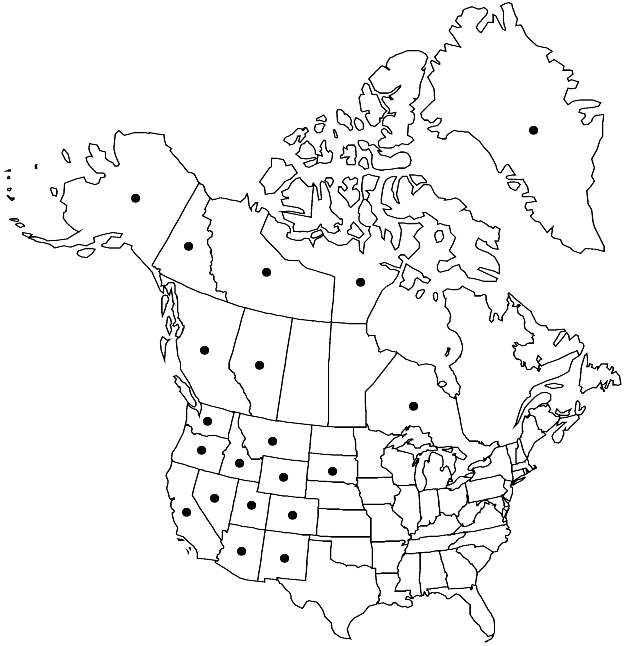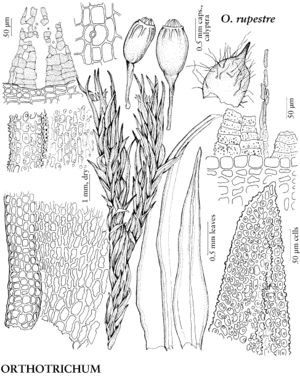Orthotrichum rupestre
Sp. Musc. Frond. Suppl. 1(2): 27, plate 53 [top]. 1816.
Plants (1–)3–12.5 cm, light green to olive green. Stem leaves stiff, erect-appressed when dry, narrowly lanceolate to ovate-lanceolate, 2–4.5 mm; margins recurved to narrowly revolute to near apex, entire; apex sharply to slenderly acute; basal laminal cells elongate to rectangular, walls thick, ± nodose; distal cells 6–13 µm, 1-stratose, papillae 1 or 2 per cell, conic and small, or 2-fid and low. Specialized asexual reproduction absent. Sexual condition gonioautoicous. Seta to 1.8 mm. Capsule immersed, emergent, or slightly exserted, usually 1/3 emergent, globose ovate, ovate-oblong, or short-oblong, 1.3–1.8 mm, slightly or distinctly 8-ribbed 1/2–2/3 length; stomata superficial; peristome single, rarely double; prostome large, conspicuous, or rudimentary; exostome teeth 16, erect or sometimes spreading-recurved when old, smooth, scattered-papillose, or coarsely papillose-granulate; endostome segments absent, or rarely 8, rudimentary, of 1 row of cells, smooth or roughened. Calyptra oblong, smooth, hairy or rarely naked, hairs finely papillose. Spores 13–21 µm.
Habitat: Non-calcareous boulders and cliff faces in mesic areas of pine, spruce-fir, or aspen forests, base of trees, subalpine shade
Elevation: low to high elevations (100-3000 m)
Distribution

Greenland, Alta., B.C., N.W.T., Nunavut, Ont., Yukon, Alaska, Ariz., Calif., Colo., Idaho, Mont., Nev., N.Mex., Oreg., S.Dak., Utah, Wash., Wyo., South America, Europe, e Asia (Japan), n, e Africa, Atlantic Islands (Canary Islands), Pacific Islands (New Zealand), Australia.
Discussion
In typical form, Orthotrichum rupestre is characterized as much-branched plants in loose tufts with lanceolate leaves, apex narrowly and bluntly acute, basal cells elongate, thick-walled, and nodose, yellowish in older leaves, capsule oblong, emergent, 8-ribbed to mid capsule when old and dry, smooth or slightly 8-ribbed when mature, exostome of 16 erect teeth, coarsely papillose, and calyptra with abundant, spinulose, papillose hairs, some of which extend over the beak.
Selected References
None.
